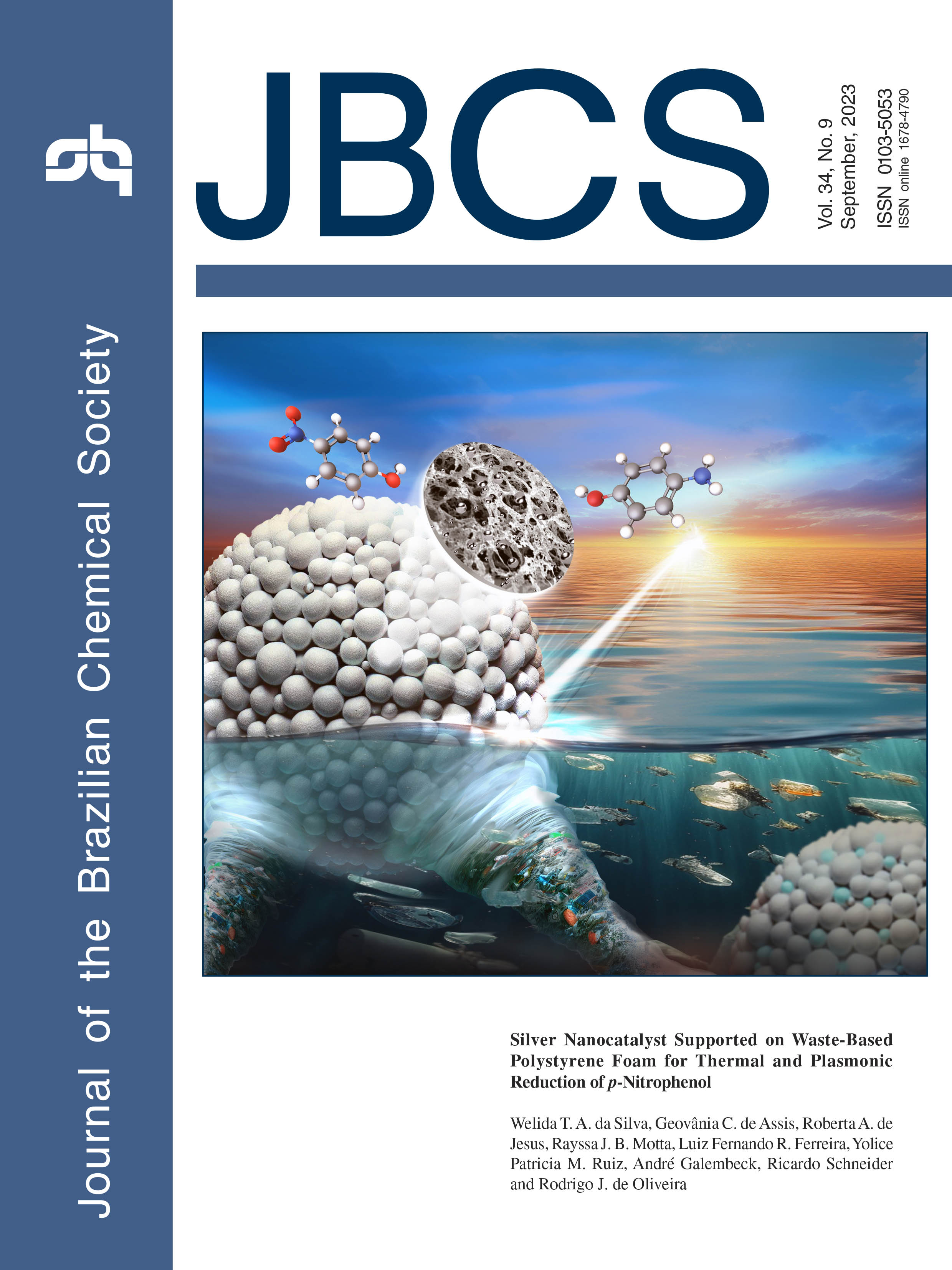vol. 34, No. 9, 2023, p. 1215-1372
Plastic debri is an environmental and health problem that is catching growing attention from scientists and society in general. Here is proposed a two in one approach to reuse this white pollution, mainly due to commercial polystyrene, turning it into a new porous material that is able to reduce organic compounds like 4-nitrophenol thanks to added nanotechnology, silver nanocatalyst. It is demonstrated that those final foams are able to preserve thermal and plasmonic catalytic features of the silver nanoparticles, opening opportunities for a new approach of reuse of plastic waste to create new multifunctional porous materials. Details are presented in the Article Silver Nanocatalyst Supported on Waste-Based Polystyrene Foam for Thermal and Plasmonic Reduction of p-Nitrophenol by Welida T. A. da Silva, Geovânia C. de Assis, Roberta A. de Jesus, Rayssa J. B. Motta, Luiz Fernando R. Ferreira, Yolice Patricia M. Ruiz, André Galembeck, Ricardo Schneider and Rodrigo J. de Oliveira on page 1317.
Silver Nanocatalyst Supported on Waste-Based Polystyrene Foam for Thermal and Plasmonic Reduction of p-Nitrophenol
Welida T. A. da Silva; Geovânia C. de Assis  ; Roberta A. de Jesus
; Roberta A. de Jesus  ; Rayssa J. B. Motta
; Rayssa J. B. Motta  ; Luiz Fernando R. Ferreira; Yolice Patricia M. Ruiz; André Galembeck; Ricardo Schneider; Rodrigo J. de Oliveira
; Luiz Fernando R. Ferreira; Yolice Patricia M. Ruiz; André Galembeck; Ricardo Schneider; Rodrigo J. de Oliveira
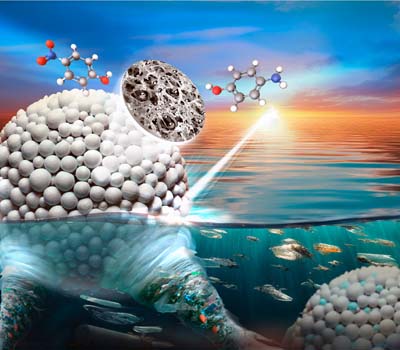
Plastic debri is an environmental and health problem that is catching growing attention from scientists and society in general. Here is proposed a two in one approach to reuse this white pollution, mainly due to commercial polystyrene, turning it into a new porous material that is able to reduce organic compounds like 4-nitrophenol thanks to added nanotechnology, silver nanocatalyst. It is demonstrated that those final foams are able to preserve thermal and plasmonic catalytic features of the silver nanoparticles, opening opportunities for a new approach of reuse of plastic waste to create new multifunctional porous materials. Details are presented in the Article Silver Nanocatalyst Supported on Waste-Based Polystyrene Foam for Thermal and Plasmonic Reduction of p-Nitrophenol by Welida T. A. da Silva, Geovânia C. de Assis, Roberta A. de Jesus, Rayssa J. B. Motta, Luiz Fernando R. Ferreira, Yolice Patricia M. Ruiz, André Galembeck, Ricardo Schneider and Rodrigo J. de Oliveira on page 1317.
https://dx.doi.org/10.21577/0103-5053.20230044
Articles J. Braz. Chem. Soc. 2023, 34(9), 1215-1223
Assessment of Ora-Pro-Nobis (Pereskia aculeata Miller) Leaves Shelf-Life in Different Conditions by Using NIR Spectroscopy and Augmented Matrices with Chemometrics
Fernanda L. Furlan; Makoto Matsushita; Aline Coqueiro  ; Paulo Henrique Março; Patrícia Valderrama
; Paulo Henrique Março; Patrícia Valderrama

Ora-pro-nobis leaves: a strategy for the shelf-life evaluation.
https://dx.doi.org/10.21577/0103-5053.20230022
J. Braz. Chem. Soc. 2023, 34(9), 1224-1235
Statistical Analysis of the Chemical Composition of Concrete Slurry Waste: A Case Study of Sedimentation Tanks from Concrete Batching Plants in Manaus-Brazil
Jéssica Raíssa M. Guimarães  ; Yves Nathan M. de Faria
; Yves Nathan M. de Faria  ; Mateus F. de Oliveira
; Mateus F. de Oliveira  ; Lizandro Manzato
; Lizandro Manzato  ; Cláudia C. Silva
; Cláudia C. Silva
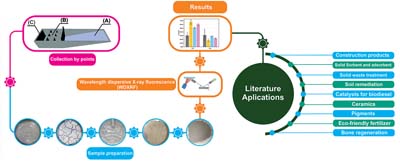
Cement sludge samples were submitted to wavelength dispersive X-ray fluorescence (WD-XRF) analysis; in view of the results obtained, the possible applications of this residue were evaluated.
https://dx.doi.org/10.21577/0103-5053.20230034
J. Braz. Chem. Soc. 2023, 34(9), 1236-1249
Physicochemical Properties of Superabsorbent Hydrogels Formed by Polyelectrolytic Complexation of Carboxymethylcellulose-Chitosan at Basic pH
Gustavo M. da Silva; Ivana L. M. Ferreira  ; Marcia P. M. Costa; Rafael F. P. Rocha
; Marcia P. M. Costa; Rafael F. P. Rocha
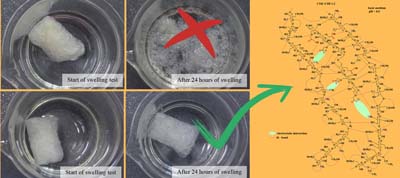
Sample prepared at basic pH remained intact after immersion in water, proving the polyelectrolyte complexes (PEC's) formation by carboxymethylcellulose-chitosan complexation.
https://dx.doi.org/10.21577/0103-5053.20230035
J. Braz. Chem. Soc. 2023, 34(9), 1250-1261
Ursolic Acid Derivatives Down Regulate Inflammatory Mediators
Elaine C. Scherrer; Ydia M. Valadares; Caio C. S. Alves  ; Alessandra P. Carli; Bárbara G. R. Fernandes; Paloma E. Carvalho; Karla A. Ramos; Maiara R. Salvador; Jeferson G. da Silva; Fernando S. Silva; Ângelo M. L. Denadai; Sandra B. R. Castro
; Alessandra P. Carli; Bárbara G. R. Fernandes; Paloma E. Carvalho; Karla A. Ramos; Maiara R. Salvador; Jeferson G. da Silva; Fernando S. Silva; Ângelo M. L. Denadai; Sandra B. R. Castro
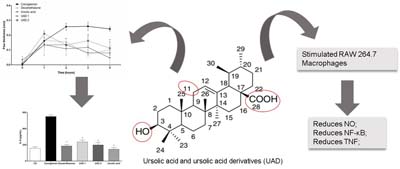
Ursolic acid derivatives reduce inflammatory mediators (nitric oxide (NO), tumor necrosis factor (TNF), interleukin-6 (IL-6) and nuclear factor kappa B (NF-κB)), and decrease the carrageenan paw edema.
https://dx.doi.org/10.21577/0103-5053.20230036
J. Braz. Chem. Soc. 2023, 34(9), 1262-1272
Stable and Thermo-Responsive Dextran Sulfate-Graft-PNIPAm Amphiphilic Nanoparticles for Potential Target Methotrexate Delivery
Aline T. dos Santos; Emerson L. da Silva; Raquel C. Montenegro; Jeanlex S. de Sousa; Regina C. M. de Paula  ; Judith P. A. Feitosa
; Judith P. A. Feitosa
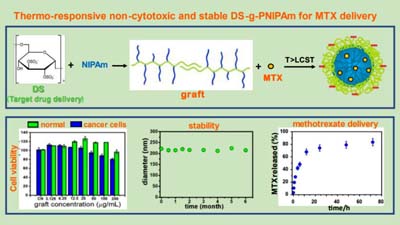
The dextran sulfate-graft-poly(N-isopropylacrylamide) (PNIPAm) is amphiphilic, stable, and non-cytotoxic. It forms nanoparticles spontaneously at temperatures close to that of the human body. It incorporates and releases a hydrophobic and extremely toxic drug, used in the treatment of cancer and rheumatoid arthritis, methotrexate, with potential targeting release due to the presence of dextran sulfate.
https://dx.doi.org/10.21577/0103-5053.20230037
J. Braz. Chem. Soc. 2023, 34(9), 1273-1283
Synthesis and Anticancer Activity of Homodimeric Morita-Baylis-Hillman Adducts Based on
3-Hydroxyindolin-2-one Core
Maísa C. Coelho  ; Aleff Castro
; Aleff Castro  ; Tayná R. Olegário
; Tayná R. Olegário  ; Rodrigo Cristiano
; Rodrigo Cristiano  ; Boniek G. Vaz
; Boniek G. Vaz  ; Gabriel F. dos Santos
; Gabriel F. dos Santos  ;
;
Lucas S. Machado  ; Gardênia C. G. Militão
; Gardênia C. G. Militão  ; Paulo B. N. da Silva
; Paulo B. N. da Silva  ; Mário L. A. A. Vasconcellos
; Mário L. A. A. Vasconcellos  ; Claudio G. Lima-Junior
; Claudio G. Lima-Junior
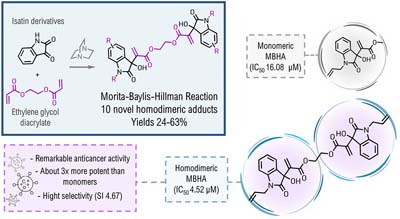
Ten novel dimeric Morita-Baylis-Hillman adducts from ethylene glycol diacrylate are reported. Some of them exhibited an increase in anticancer activity and selectivity, compared to the respective monomeric adducts.
https://dx.doi.org/10.21577/0103-5053.20230038
J. Braz. Chem. Soc. 2023, 34(9), 1284-1292
Photocatalytic Degradation of Bentazon Pesticide by a Fe2O3-TiO2 Composite Catalyst Irradiated by UVA, UVB, and Natural Light
Cristian S. Braga; Guilherme G. Bessegato; Keiti Maestre; Fernando R. Espinoza-Quiñones; Helton J. Alves; Leandro C. da Silva;
Renato Eising; Reinaldo A. Bariccatti

Photocatalysis is a useful tool for environmental remediation. Bentazon molecules can be decomposed into simpler substances by the action of the catalyst (Fe2O3-TiO2) and sunlight (22,000 lux).
https://dx.doi.org/10.21577/0103-5053.20230039
J. Braz. Chem. Soc. 2023, 34(9), 1293-1302
Molecular Modeling Studies of β-Sitosterol Extract from Miconia burchellii Triana (Melastomataceae) from Brazilian Cerrado
Marianna C. Silva  ; Vitor S. Duarte; Lóide O. Sallum
; Vitor S. Duarte; Lóide O. Sallum  ; Gracielle O. S. Cunha; Jean M. F. Custodio; Allen G. Oliver;
; Gracielle O. S. Cunha; Jean M. F. Custodio; Allen G. Oliver;
Josana C. Peixoto; Antônio C. S. Menezes; Hamilton B. Napolitano
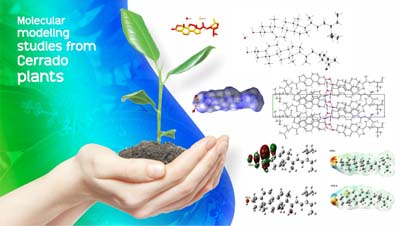
Molecular modeling studies from Cerrado plant.
https://dx.doi.org/10.21577/0103-5053.20230040
J. Braz. Chem. Soc. 2023, 34(9), 1303-1308
Theoretical Study of 2,6-Dichloro-3-methyl-1,4-benzoquinone Interacting with Graphene
Leandro C. Sobrinho; Silvete Guerini
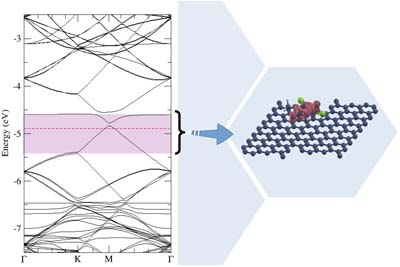
Electronic band structure and plot of the local density of states for 2,6-dichloro-3-methyl-1,4-benzoquinone molecule interacting graphene in configuration most stable.
https://dx.doi.org/10.21577/0103-5053.20230041
J. Braz. Chem. Soc. 2023, 34(9), 1309-1316
Featured Properties of the Adsorption of Tebuconazole on Ag Surface Characterized through SERS Spectroscopy
Rafael de Oliveira  ; Antonio Carlos Sant'Ana
; Antonio Carlos Sant'Ana
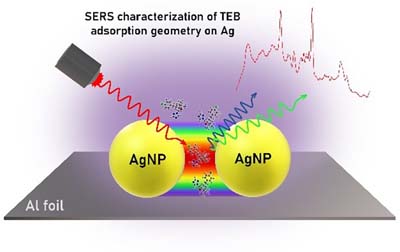
Adsorption geometries for tebuconazole on silver surface, in different hot spots, were proposed based on studies involving surface-enhanced Raman scattering (SERS) spectroscopy.
https://dx.doi.org/10.21577/0103-5053.20230042
J. Braz. Chem. Soc. 2023, 34(9), 1317-1332
Silver Nanocatalyst Supported on Waste-Based Polystyrene Foam for Thermal and Plasmonic Reduction of p-Nitrophenol
Welida T. A. da Silva; Geovânia C. de Assis  ; Roberta A. de Jesus
; Roberta A. de Jesus  ; Rayssa J. B. Motta
; Rayssa J. B. Motta  ; Luiz Fernando R. Ferreira; Yolice Patricia M. Ruiz; André Galembeck; Ricardo Schneider; Rodrigo J. de Oliveira
; Luiz Fernando R. Ferreira; Yolice Patricia M. Ruiz; André Galembeck; Ricardo Schneider; Rodrigo J. de Oliveira

Polystyrene waste, also known as white pollution, has been repurposed as support for silver nanocatalyst. Those nanofoams were able to convert p-nitrophenol into aminophenol under plasmonic excitation.
https://dx.doi.org/10.21577/0103-5053.20230044
J. Braz. Chem. Soc. 2023, 34(9), 1333-1346
Controlled Release of Rutin from Babassu Coconut Mesocarp Starch Films
Liane M. Carvalho  ; Cicero W. B. Bezerra
; Cicero W. B. Bezerra  ; Claudia Q. da Rocha
; Claudia Q. da Rocha  ; Letícia N. de Oliveira
; Letícia N. de Oliveira  ; Luna N. Vasconcelos
; Luna N. Vasconcelos  ; Sirlane A. A. Santana
; Sirlane A. A. Santana
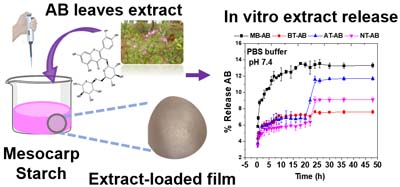
Schematic representation of the production of babassu mesocarp films loaded with Arrabidaea brachypoda leaf extract and controlled release assay at pH 7.4.
https://dx.doi.org/10.21577/0103-5053.20230045
J. Braz. Chem. Soc. 2023, 34(9), 1347-1352
Evaluation of the Metabolic Production from the Co-Culture of Saccharicola sp. and Botryosphaeria parva, an Endophytic Fungi Associated with Eugenia jambolana Lam.
Mayra F. Costa; Maiara S. Borges; Vanessa M. Chapla  ; Carolina R. Biasetto; Isabele R. Nascimento
; Carolina R. Biasetto; Isabele R. Nascimento  ; Vanderlan S. Bolzani; Angela R. Araujo
; Vanderlan S. Bolzani; Angela R. Araujo
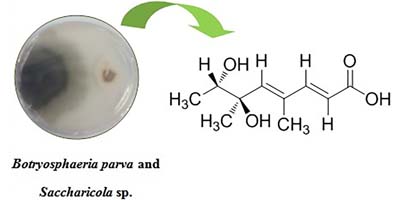
A new carboxylic acid and eight known compounds were isolated from co-culture of Saccharicola sp. and Botryosphaeria parva, an endophytic fungi in Eugenia jambolana.
https://dx.doi.org/10.21577/0103-5053.20230046
J. Braz. Chem. Soc. 2023, 34(9), 1353-1359
New Catalysts Derived from Natural Products as Highly Stereoselective Chiral Inductors for Diethylzinc Addition to Aromatic Aldehydes
Celso L. Wosch; Ricardo Labes; Kahlil S. Salome; Vitor S. Melo; Renan R. Schorr; Palimécio G. Guerrero Jr.; Nathalya K. Lima; Gustavo Frensch; Beatriz H. L. N. S. Maia; Francisco A. Marques
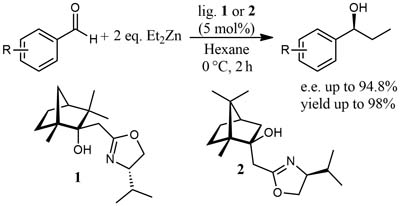
Chiral ligands derived from (+)-camphor and (-)-fenchone for the addition of diethylzinc to aromatic aldehydes showed enantiomeric excess up to 96%.
https://dx.doi.org/10.21577/0103-5053.20230047
J. Braz. Chem. Soc. 2023, 34(9), 1360-1372
Voltammetric Study on the Electrowinning of Cobalt in the Presence of Additives
Danielle C. de Castro  ; Iranildes D. dos Santos
; Iranildes D. dos Santos  ; Marcelo B. Mansur; Achilles J. B. Dutra
; Marcelo B. Mansur; Achilles J. B. Dutra
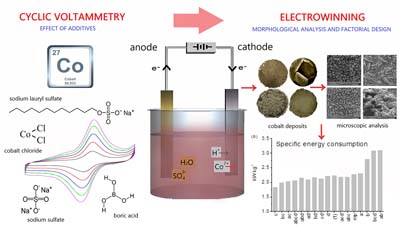
Cyclic voltammetry was applied to investigate the influence of some organic and inorganic additives on cobalt electrowinning since it is an energy-intensive process and requires an industrially acceptable cobalt deposit production at low operating costs.
https://dx.doi.org/10.21577/0103-5053.20230048
Online version ISSN 1678-4790 Printed version ISSN 0103-5053
Journal of the Brazilian Chemical Society
JBCS Editorial and Publishing Office
University of Campinas - UNICAMP
13083-970 Campinas-SP, Brazil
Free access










